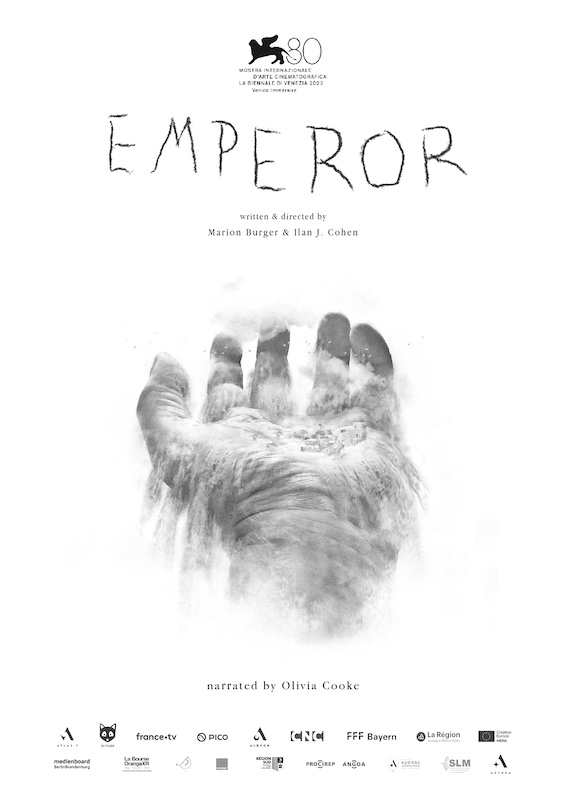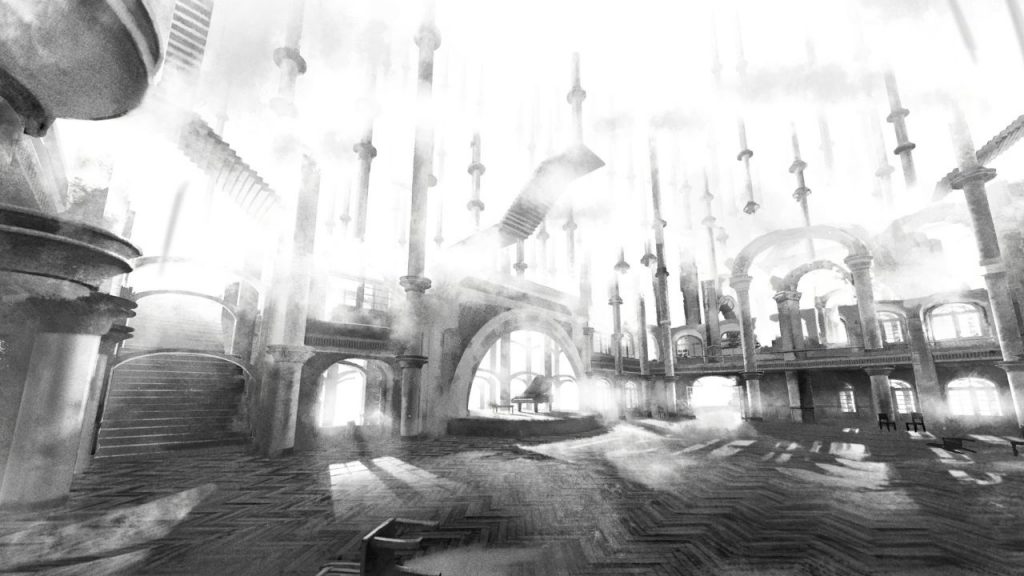After a stint at the Biennale College de Venise 2021 (followed by a work-in-progress session at Annecy 2023), EMPEREUR makes its world premiere at the Mostra 2023 – in the Venice Immersive Competition. Produced by Atlas V (Oriane Hurard), EMPEREUR is a strong narrative, adapted from a true story about a father’s aphasia as told by his daughter, but also visually dazzling in its minimalism, which perfectly embraces the VR medium. We take a look back at this sensitive experience with its co-writers Marion Burger and Ilan Cohen.
The virtual reality perspective… With transmedia?
Ilan Cohen – I discovered the world of new writing and virtual reality through various discussions, notably with Pierre Cattan (Small Bang, France), but above all through a project in Japan linked to the painter Tsugouharu Foujita. I accompanied a feature film project to create photogrammetric sequences around these living spaces. I discovered the sense of staging for VR, for spaces that are the opposite of a 2D image. Above all, it gave me the opportunity to think about the editing and sequencing of this type of project. To be able to navigate through these memories, reconstructed virtually, to imagine a real poetic journey on this medium. It was thanks to this, in particular, that I was able to offer Marion the chance to try out virtual reality when she asked me to co-direct her project.
Marion Burger – As it happens, I come from the world of cinema, and the set design department. I’ve always had a cross-disciplinary artistic approach (costume, set design, cinema…). My approach to digital is linked to this practice, which is ultimately very manual. I didn’t have much of a videogame culture, even when it came to video games. My first idea for EMPEREUR was to make an animated film. But virtual reality was a natural choice because of its ability to reveal a point of view, to get inside someone’s head (and hands). It made sense for the story, beyond the medium. Virtual reality and its innovative aspect appealed to me because it’s still in an almost experimental industry where everything is still possible. As an author, I could try and test things. Starting with video games, and understanding pure gameplay processes!

EMPEREUR, about points of view
M. B. – EMPEROR is a story told from a young woman’s point of view, as she watches her father suffer aphasia after a stroke. He can no longer communicate with the outside world. For Ilan and me, it was this interplay of views that was important, and we built the story around the daughter’s point of view, and in certain sequences the father’s. In reality, you can’t know what’s going on. In reality, we can’t know what’s going on in this second case, so we built EMPEROR on a set of interpretations and suppositions on my part. In the staging, there’s this idea of stepping back. And it was essential to maintain an objective viewpoint. Of course, we gradually get to the intimate, but we propose that the spectator start from the beginning, from the accident, and then show the reality of the aftermath. At the same time, we fantasize a whole world, playing with scales and so on. There’s a kind of blissful surrealism available to talk about these subjects.

I. C. – We also benefited from the financing cycle of these new works, which allowed us to iterate and imagine a lot. Even in the creative process, we were able to take a step back and pause to refine our ideas. A lot of things settled down in the last phase, whereas the writing phase was a kind of psychoanalytical discussion between Marion and me to understand her own relationship with her father. There’s some very personal material that we had to integrate into a more universal vision. So that I could also bring my own interpretation to it, and find the right angles.
M. B. – I had very precise ideas, but in the end they were very abstract, and I had to create a story to integrate them. In fact, the initial voice-over text remained unchanged. I have personal memories, my own reactions, and the visuals that go with them. But it’s all sensory, which had to be reworked.
A non-fiction film, an interactive documentary or something else?
I. C. – Documentary or fiction? We don’t try to fit into a single classification, as we ourselves find it hard to define EMPEREUR. Documentary is perhaps closer, even if that’s not all we’ve done. Virtual reality is, as Marion says, still partially unknown territory, where we felt we had a little more freedom to create. The final form matches the story we wanted to tell, and that’s the most important thing!
M. B. – In any case, I never wanted to turn my family history into a documentary, in the sense that I would have had to show my father, to embody something directly. There’s bound to be an influence, a link with me. But from this reality I extracted what I wanted to use, to transform it (even slightly).

I. C. – … I began our discussions about the script by describing EMPEROR as a poetic documentary. But that was just my perception. Marion’s memories give the project a very unique character. We saw a lot of things in VR as part of our preparation, and ultimately few experiences with immersion dedicated to empathy. That was one of our objectives, to take the viewer on a sensory and empathetic journey. This also led us to meet with medical institutions, with a lot of feedback concerning caregivers – and not immediately patients. If this can meet a need to express the lives of caregivers, of people who accompany the sick, so much the better!
M. B. – We don’t talk about the rest of my family in this project, because that’s not the point. But EMPEROR is about all those people. The need to understand this context, these difficulties, the wall between the patient and his loved ones. We tried to portray this as best we could, in this new, highly complex social context. I tried to render in a poetic way something that can be frightening at first sight.
An interactive disease experience
I. C. – I had a certain culture of video games, but that didn’t prepare me for thinking in depth about EMPEREUR’s interactivity. Marion and I quickly agreed to put all our ideas on the table! She was the one who guided me through this process, to select those that would be coherent. We realized that the VR stories that made little use of interactivity had, like us, a real focus on the point of view. So we had to keep it, because the main character can’t do much – and manage a balance until the end with this information.

I. C. – Because we quickly realized that to maintain a certain level of attention, our story had to involve the viewer. But in small doses! We had to be a little dirigiste, a little Manichean, to guide the viewer – without losing our observational edge. In short, we had to avoid giving in to the urge to overdo things or multiply situations. This can quickly lead to impatience. This isn’t a game (and we love SUPERHOT!), we had to cultivate emotion. And the support provided by the studio, Albyon, was important in this respect.
M. B. – Obviously, every action had to be linked to the story. Once again, this isn’t cinema: you can allow yourself a few actions for fun, but in reality you risk losing the viewer. Immersion has to be thought through in this sense. For example, we thought of using the voice – which is developing in VR – but it didn’t work… So it’s the hands that have become a form of expression, with hand-tracking very useful here, and interactions that don’t require our dominant hand. And at certain moments, to create frustrations linked to aphasia, to show the limits of the body…
Minimalist staging to fit the format
M. B. – We proposed a minimalist scenography based on the absence of elements. And that’s where our recent arrival in the medium helped us to try this type of adventure… Because the further we went, the more we removed. And it worked!
I. C. – I have memories of my first steps in VR where the hyper-realism made me sick. The fact that I was confronted with settings that were too real blocked me a little. It’s probably a first impression that wouldn’t be true today, but in any case I wanted to go for a black-and-white universe that wouldn’t go for too much detail.
M. B. – From the very start of this project, I wanted to go for black-and-white animation, close to a hand-drawn style. And by going for virtual reality, I didn’t want to go for an over-smooth 3D environment. I come from the material, and the story is about a world that’s become clumsy, a bit broken… So we had to preserve these ideas. Going back to the sketching stage and using a hand-crafted line suited me very well.

I. C. – The strong aesthetic desire is common. It supports a mise-en-scène that supports the looks, but also aids the direction. In a totally white environment, we could move our camera more easily. Right from the opening sequence, aboard a train where only the rails appear, we open up the possibilities to the viewer, who can recreate the rest in his or her own imagination. Conversely, this meant we had to work hard on sound and music to fill the space. Fortunately, we have a lot of time for this part of the project.
Listen to the music (Soundcloud)
EMPEROR Credits
Written and directed by Marion Burger et Ilan J. Cohen
With the voice of Vimala Pons (French version), Olivia Cooke (english version)
Music by Jamie Turner (Heran Soun) & Gaspar Claus
Produced by Oriane Hurard
A coproduction Atlas V (France), Reynard Films (Germany), France Télévisions, Pico
With the support of CNC, FFF Bayern, Région Auvergne-Rhône-Alpes, MEDIA
Creative Europe, Medienboard Berlin-Brandeburg, Bourse
Beaumarchais Orange XR, Région Sud, Procirep-Angoa, Fondation Audiens Générations, SLM, Astrea
Production Albyon



Leave a Reply
You must be logged in to post a comment.